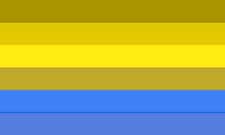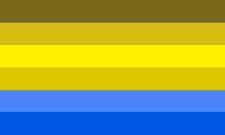Color-blindness is the inability to distinguish the differences between certain colors. This condition results from an absence of color-sensitive pigment in the cone cells of the retina, the nerve layer at the back of the eye. (See "Look Inside the Eye.")
Most color vision problems are inherited and are present at birth. Approximately 1 out of 12 males and 1 out of 20 women are color blind.
What does a color-blind person see?
A person with color-blindness has trouble seeing red, green, blue, or mixtures of these colors. The most common type is red-green color-blindness, where red and green are seen as the same color.
Here are some illustrations of the most common forms of color-blindness:

The colors of the rainbow
Normal color vision

The colors of the rainbow
Deuteranope (simulation)
Absence of green retinal photoreceptors

The colors of the rainbow
Protanope (simulation)
Absence of red retinal photoreceptors.

The colors of the rainbow
Tritanope (simulation)
Absence of blue retinal receptors
Tests for Color-Blindness
The typical test for color-blindness is based on a person's ability to see numbers inside a circle.
Before you look at these tests, be aware of the following:
1. Your computer and monitor may not display the colors accurately. If you cannot see the number that does not necessarily mean you are color-blind. The numbers may more visible with some resolutions and display settings than with others.
2. The results of this test are not to be considered a valid medical test for color blindness and merely serve to illustrate the tests available. If you have any questions about your own possible color vision deficiencies consult a licensed medical professional.
Here is a sample of charts used to test for color-blindness.
There is a number in the center of the circle.
If you can see the number, chances are you are not color-blind.
|
|
|
|
Plate 1 |
Plate 2 |
|
|
|
|
Plate 3 |
Plate 4 |
Here are the answers:
Plate 1
Those with normal color vision should read the number 74.
Plate 2
Those with normal color vision should read the number 6.
Plate 3
Those with normal color vision should read the number 29.
Those with red-green deficiencies read the number 70.
Those with total color-blindness can not read any number.
Plate 4
Those with normal color vision should not be able to read any number.
Most of those with red-green deficiencies should read the number 5.
Those with total color -blindness can not read any number.
For the entire Ishihara test see Color Blindness Tests
For more information, please see the following resources on the Web:
Pediatric Color Vision Test for 3 - 6 Year Old Pre-School Children
How the Color Deficient Person Sees the World
You might also be interested in ...
![]()
Do bulls really see red? Do bees have super color vision?
Find out more at Color Matters: How Animals See Color
Learn more from Color Matters
Online learning from the author of Color Matters.







